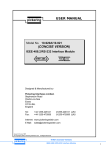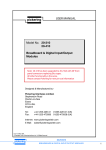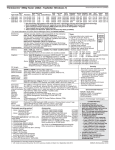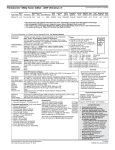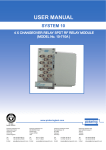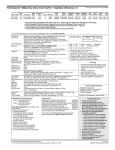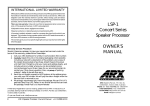Download ARX High-Performance Loudspeakers Owner`s manual
Transcript
INTERNATIONAL LIMITED WARRANTY ARX Systems (ARX) warrants to the first purchaser of any ARX equipment that it is free from defects in materials and workmanship under normal use and service. ARX’s sole obligation under this warranty shall be to provide, without charge, parts and labour necessary to remedy defects, if any, which appear within twelve (12) months from date of purchase, and for a further twelve (12) months supply parts only. This is our only warranty. It does not cover finish or appearance items, burned voice coils, or if the equipment has been, in ARX’s sole judgement: •Subjected to misuse, abuse, negligence or accident; •Repaired, worked on, or altered by persons not authorized by ARX; •Connected, installed, adjusted or used for a purpose other than that for which it was designed. This includes running a speaker system with the ISC leads disconnected, or with a non-ARX crossover, or with the wrong processor. LSP-2 Concert Series Speaker Processor This warranty gives you and us specific legal rights and you may also have other rights which may apply. Warranty Service Procedure Should it become necessary to have your equipment serviced under the terms of the warranty, please follow these steps: 1. Call your ARX distributor for a Return Authorization (RA) number; 2. Carefully repack the unit, in its original packaging where possible, including a note with a description of the problem, and a copy of the receipt showing date of purchase. Attach these to the actual unit itself. Don’t forget to write your name and address clearly, and include a phone number where you can be contacted during normal business hours. Make it easy for our service technicians to contact you if they have a question. Also, use plenty of packing material - better to be safe than sorry. 3. Send the unit freight prepaid to ARX Systems, at the address given you with your RA number. We will pay the return freight when the serviced unit is returned to you. 4. We strongly recommend you insure the package. We can’t fix it if it gets lost! Send it by UPS, Fedex, or any similar service that can track the package. Parcel Post is not recommended If Warranty Registration Card is missing, please write to ARX in the country of purchase, stating model and where purchased, or to ARX, PO Box 15, Cheltenham, Victoria 3192, Australia. Or you can Email us at: [email protected] 8 LSP-2 Speaker Processor Owner's Manual v 2.2 CE ©2000 ARX® OWNER’S MANUAL ARX Systems Pty Ltd, PO Box 15, Cheltenham, Victoria 3192, Australia Phone: 03 - 9555 7859 Fax: 03 - 9555 6747 International Fax: +61-3 -9555 6747 On the Web: http://www.arx.com.au Email: [email protected] LSP-2 Speaker Processor Owner's Manual v 2.2 CE ©2000 ARX® IMPORTANT - PLEASE READ THIS FIRST This is a dual voltage unit. It is essential that you check that the voltage on the fuseholder cover below the AC connector on the rear of the chassis is set correctly before connecting it to AC power. THIS IS SET FOR 100 V AC TO 120 V AC OPERATION THIS IS SET FOR 220 V AC TO 240 V AC OPERATION To change, pull fuseholder out and rotate 180o, then push in again. Do not insert power cable into unit until voltage has been correctly set. Do not plug power cable into AC power until voltage has been correctly set WARNING SYMBOLS USED ON THIS EQUIPMENT This symbol is intended to alert you to the presence of important operating instructions contained in this owner's manual This symbol is intended to alert you to the presence of uninsulated dangerous voltage within the product's enclosure that may be of sufficient magnitude to constitute a risk of electric shock. This symbol indicates that a Slow Blow fuse is used in this equipment. Replace with same type and value only Complies with 89/336/EEC EMC Directive, amended by 92/31/EEC and 93/68/EEC and meets the following standards:EN 55013 : 1990, Sections 3.2 and 3.5 EN 55020 : 1988, Sections 4.3, 5.4, 6.2, 7.0, 8.0. Complies with Australian Standard AS/N25 1053 2 LSP-2 Speaker Processor Owner's Manual v 2.2 CE ©2000 ARX® LSP 2 Specifications Input Impedance Maximum Input Level Input Level Control CMRR Output Impedance (Band 1 & Band 2 output) 20Kohms Electronically balanced +20dB infinity – 0dB (no gain) >50dB @ 1KHz 300 ohms Balanced 150 ohms Unbalanced Maximum Output Level +22dB Low Output Level Control infinity – +6dB (gain) Signal to Noise Ratio –96dB Band 1 output –93dB Band 2 output Frequency Response 20Hz—20KHz summed Dynamic Range 118dB Band 1 output 115dB Band 2 output Distortion (THD) <.004% Crossover Frequency Dependent upon loudspeaker model Crossover Filter Type Linkwitz Riley 24dB per octave High Pass Filter Dependent upon loudspeaker model; Modified Butterworth type, 24dB per octave High Frequency Equalisation Variable, dependent upon loudspeaker model ISC Returns 20K ohms Differential Input ISC Return Connector Type 2 x Male 6 Pin Socket. Pins 1 & 2 Low return Pins 3 & 4 High return Input /Output Connector type XLR Power Requirements 100–120, 220–240 VAC, 50-60 Hz, 5 VA Weight 5 lbs/2.2 Kg Dimensions 19"W x 1¾"H x 6"D, 482 x 44 x 155mm LSP-2 Speaker Processor Owner's Manual v 2.2 CE ©2000 ARX® 7 Front Panel controls Model LEDs One of this group of LEDs light up to show which Plug-in card is installed in Channel A, and that the unit is connected to AC power. Channel A level trim These controls let you adjust the input level to the unit. During normal operation it is set at the maximum (10) position. Note: this is an attenuator only, not a gain control. Setting this level too low may reduce the headroom in the preceding equipment. All remaining controls are recessed behind an acrylic security cover to prevent unauthorized access. Unscrew the knurled nut at each end of the cover and lift off to make adjustments. Replace security cover afterwards. Band 1 (the Lower filter) control This control determines the Low Frequency output of your system. During normal operation it is set at the 0dB (unity) position (12 o’clock). It also provides up to +6 dB of gain past unity. This can be used for 2 purposes: 1. To achieve an increase in Low frequencies in relation to the Highs 2. Level compensation for amplifiers with differing input sensitivities Input A: Connect signal feed from the Console here Output Band 1 (LF) A: Connect the signal feed to the Lower Frequency Power Amp here Output Band 2 (HF) A: Connect the signal feed to the Higher Frequency Power Amp here. Channel B connections identical Connecting the ISC leads (Important!) The White and Blue ISC leads, on 6 pin XLR connectors, plug into the corresponding sockets on the rear of the Control Unit. These leads allow the LSP-2 to monitor the output of the amplifiers, and to activate the protection circuits if the power exceeds the maximum safe operating area of the speaker. The unit won’t turn on until you make these connections! • The WHITE leads connect to the OUTPUTS of the LOW amplifiers, in parallel with the leads going to the LOW speakers. The BLUE leads connect to the Outputs of theHIGH amplifier, in parallel with the leads going to the HIGH speakers. • Don’t get these mixed up as you will end up with the LOW ISC controlling the HIGHs, and vice versa, which can cause major speaker damage to the HIGH drivers. • Make sure that the Channel A ISC leads are connected to the Channel A amplifi- Band 1 Signal/ISC LEDs The Signal LED shows you that some signal is running through the LSP-1. The ISC LED indicates that the ISC protection circuitry is operating on the Low (Band 1) output. During normal operation this LED will light up on transients or peaks if the system is being used to achieve high SPL. This is normal, and should not be taken as an indication that the system is being overdriven. However, if this LED is on for the majority of the time, then the Low level is too high and should be reduced. Channel A Input from console (or LSP-1 Loop outputs) 6 pin ISC connector for Channel A Band 2 (the Higher filter) control and Signal/ISC LEDs Same as for Band 1(Lower) but applicable to the Higher filter VHF level trim control This control determines the Very High Frequency energy output of your system. It provides control from -12 dB (Hard LEFT) through to 0 dB/unity (Hard RIGHT). It should be set in the 0 dB position for a flat response, but for a more musical response you can rotate it anti-clockwise until the desired roll off is achieved. Channel B controls are identical in operation Channel A Band 1 (Low) and Band 2 (High) Outputs To Low and High amplifier inputs Channel A Channel A Low and High ISC return leads back to LSP-2 Rear Panel Connections Only Channel A connections shown in diagram. Channel B connections identical but omitted for clarity 4 LSP-2 Speaker Processor Owner's Manual v 2.2 CE ©2000 ARX® To High speaker To Low speaker LSP-2 Speaker Processor Owner's Manual v 2.2 CE ©2000 ARX® 5 ers, and Channel B leads to the Channel B amplifiers, or you will end up with the Channel A ISC controlling Channel B and vice versa, which can give very strange results. • Work slowly and carefully, and take the time to get it right. It’s a good idea to mark all leads as you go, so you can visually check all connections before powering up. Plug-In Parameter card modules The LSP-2 2way Loudspeaker Processor is a general non-Model-specific Loudspeaker Management Platform. The variable parameters required for each model, such as High Pass Filter, Frequency Response Contour, Phase Response, High Frequency Equalisation (LSP-2 only) and Loudspeaker Component Power Handling Limits are all set on our new “Plug in Card” system. Each ARX Loudspeaker model now has its own dedicated Preset Card, ensuring predictable performance and the ability to update Loudspeaker Performance simply by plugging in new PCB cards. This ‘user-friendly’ innovation enables easy re-configuration for different ARX Loudspeaker models without the need to remove and replace components on the unit’s Printed Circuit Board. The LSP-2 Loudspeaker Processor can also be supplied calibrated to other manufacturer's (non ARX) speaker systems. For full details see our “Custom Plug-In Card Technical Parameters’ fact sheet. The following Model numbers apply: Loudspeaker Model Processor Platform & required Module Card for 922 Loudspeakers order LSP-2/M922 for 212 Loudspeakers order LSP-2/M212 for 215 Loudspeakers order LSP-2/M215 for 212 Loudspeakers order LSP-2/M222 for user defined system order LSP-2/MOPEN The module cards are also available separately and can be ordered by using the following model numbers: for 922 Loudspeakers order for 212 Loudspeakers order for 215 Loudspeakers order for 212 Loudspeakers order for user defined system order M922 M212 M215 M222 MOPEN Introduction Thank you for choosing this ARX speaker system. We understand that you are keen to use your new purchase, but before you do, and to ensure continued trouble free use, please familiarise yourself with the contents of this owner's manual before plugging any leads in or connecting up to AC power. In particular, pay close attention to the section on connecting the I.S.C. leads to the processor. The colour code and channel selection is particularly critical when putting the system together for the first time. Severe speaker damage can be caused by incorrect wiring, and is not covered by the terms of your warranty. So please, take it easy and check things as you go. What is I.S.C? I.S.C stands for Interactive System Control, ARX’s innovative Speaker and Electronics Interface. There is a lot of hyperbole attached to the Electronic Processing of speaker systems, but if we look at what’s happening in an purely audio electronics context, we find that irrespective of the name attached to this style of Speaker System they all basically perform the same functions. The Basic Principles of Feedback style Gain Control ISC monitors the output of the power amplifier driving each set of Loudspeaker components and compares this signal with an internal model of the SOA (safe operating area) of the driver. When the signal applied to the driver tries to exceed that SOA, the signal is limited or held at a level which is safe for the driver to reproduce. As the driver signal forms part of a feedback style loop this SOA can never be exceeded. Why monitor the outputs of the amplifiers? What interests us is the actual power being applied to loudspeaker components, not the signal being applied to the input of the Power Amplifier. To measure this accurately and allow the user their personal choice in Power Amplifiers we have to go where the action is - the outputs of the amplifier. This is used as the reference. What size amplifier do I need? You’ll notice that on all ARX speaker system spec sheets we quote a “recommended minimum amplifier size” - we don’t quote power handling. The ISC processor determines the amount of power supplied to each speaker, ensuring this remains within the SOA of the driver. But by recommending the minimum amplifier size we are indicating that this is the least amount of available power required for ISC to operate in the way it was designed by ARX engineers. Where do I put the processor? The processor is mounted with the Amplifiers in the amp rack. In most applications once the main frequency response balance is set, system equalization is achieved by a Graphic or Parametric Equalizer, so there is no need to constantly access the processor. 6 LSP-2 Speaker Processor Owner's Manual v 2.2 CE ©2000 ARX® LSP-2 Speaker Processor Owner's Manual v 2.2 CE ©2000 ARX® 3




